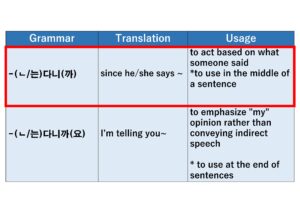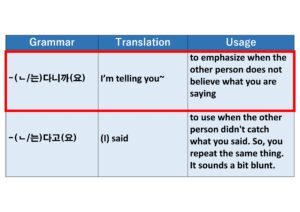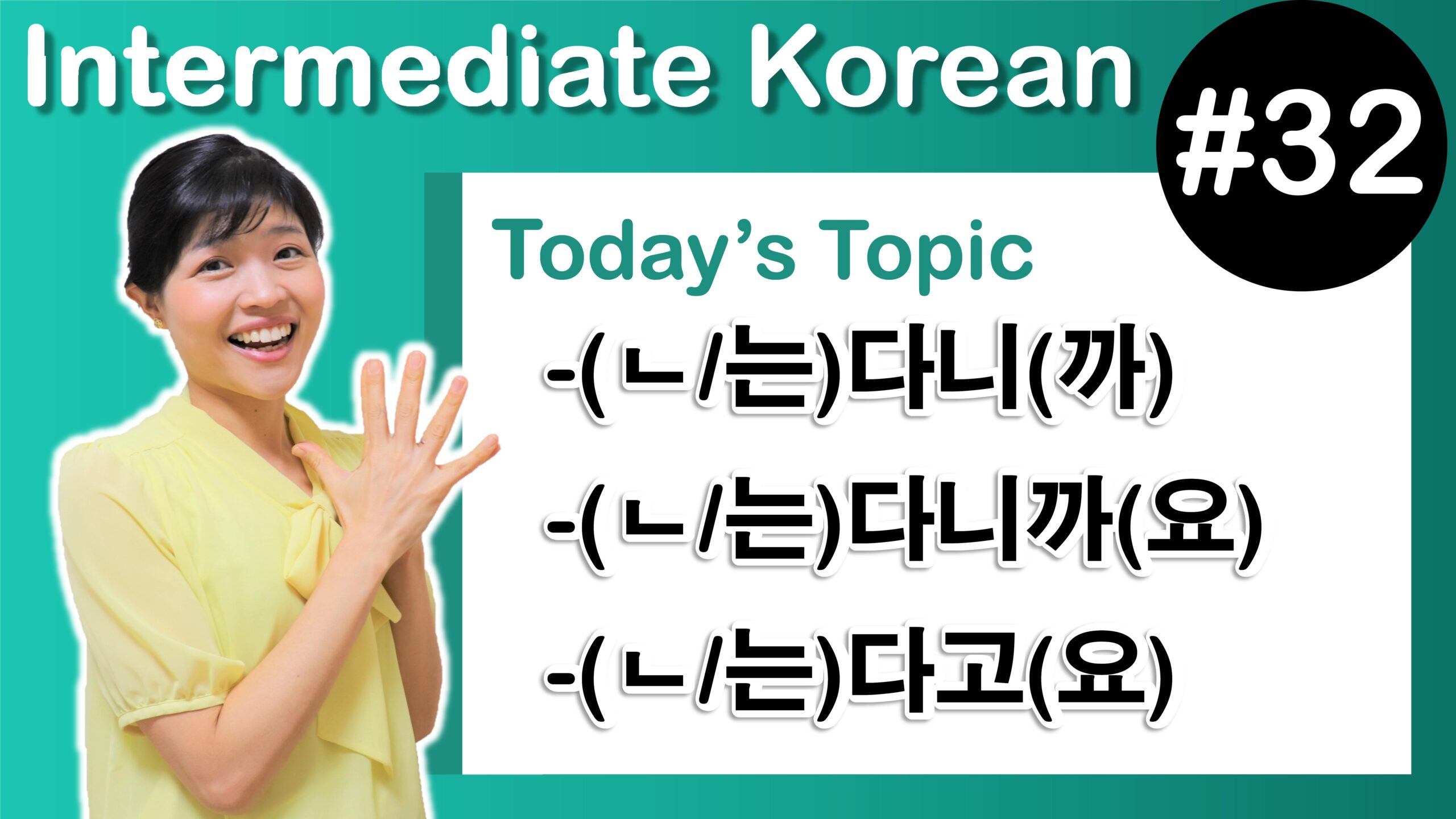안녕하세요! 토미입니다!
Let’s have fun learning Korean today!
The grammar we will learn today is:
① -(ㄴ/는)다니(까) “because (he/she) says that~”
② -(ㄴ/는)다니까(요) “I’m telling you that~/ I told you~”
③ -(ㄴ/는)다고(요) “(I) said~”
If you learn today’s grammar, you will be able to use expressions like:
그날 외계인을 내 눈으로 똑똑히 봤다니까요!
I told you I saw the aliens clearly with my own eyes that day!
Like this example, you can articulate your point of view more clearly.
Putting strength in your story like a native Korean, I am sure you’ll become a master of intermediate Korean!
You’re all so talented, so let’s achieve our goals!
그럼 시작할게요!
–(ㄴ/는)다니(까)
Verbs(without a final consonant) + ㄴ다니까
Verbs(with a final consonant) + 는다니까
Adjectives+ 다니(까)
Nouns(without a final consonant) + 라니(까)
Nouns(with a final consonant) + 이라니(까)
First grammar, -(ㄴ/는)다니(까) is a contraction of -(ㄴ/는)다고 하니(까) “since (he/she) says that~.” It is indirect speech.
It doesn’t matter if you add 까 or not, but Korean people use the form with 까 often in conversation.
You use -ㄴ/는다니(까) for verbs.
You attach -ㄴ다니까 if a verb stem does not have a final consonant.
For example, 가다 “to go” does not have a final consonant.
So, you add -ㄴ다니까 to make 간다니까 “since (he) says (he) goes.”
If a stem has a final consonant, you add -는다니까 to the stem.
For example, 먹다 “to eat” has a final consonant.
So, you add 는다니까 to make 먹는다니까 “since (he) says (he) eats.”
For adjectives, you use -다니(까) regardless of a final consonant.
This is as easy as pie!!
For nouns, you add -(이)라니(까).
Now, let’s check it out with an example sentence.
Verbs: Example 1
친구가 10분 이내로 도착한다니까 좀만 더 기다려 보죠.
Because my friend says he will arrive within 10 minutes, let’s wait a little longer.
Here, 도착하다 “to arrive” is a verb without a final consonant.
So, what do you have to add? -ㄴ다니까!
You attach -ㄴ다니까 to make 도착한다니까 “because (my friend) says (he) will arrive.”
Let’s look at the following example sentence.
Adjectives: Example 1
오늘은 오빠가 바쁘다니까 내일 만나기로 했어.
Because Oppa says he is busy today, I decided to see him tomorrow.
Here, 바쁘다 “to be busy” is an adjective, so what must you add?
-다니까.
Yes!! You attach -다니까 to make 바쁘다니까 “Because (he) says (he) is busy.”
Let’s look at the following sentence.
Nouns: Example 3
우리 손주가 요리는 이번이 처음이라니까 잘 좀 가르쳐 주세요.
Since my grandson says this is his first time cooking, please teach him how to cook well.
Here, 처음 “first time” is a noun with a final consonant, so you attach -이라니까 to make 처음이라니까 “since (my grandson) says (this is his) first time~.”
Quiz
Now, let’s master this indirect speech through quizzes! What number will be in the blank?
1. 니가 나를 ( ) 나도 너를 믿을게.
I will believe in you since you say you believe in me too.
(1)믿으니까 (2) 믿는다니까
The correct answer is (2).
Since 믿다 “to believe” is a verb with a final consonant, you attach -는다니까 to make 믿는다니까 “because you say you believe.”
Number one is wrong because 믿으니까 means “since I believe.”
It does not have the meaning of indirect speech.
Now, let’s read it with a feeling of trust!
니가 나를 (믿는다니까) 나도 너를 믿을게.
Please read it until you can put your heart into it.
Now, on to the following quiz!
2. 언니가 ( ) 집에 가 봐야 될 것 같아요.
Since my sister says she is not feeling well, I must go to her house to check on her.
(1)아픈다니까 (2) 아프다니까
The correct answer is (2).
아프다 “not feeling well” is an adjective, so you attach -다니까 to the stem to make 아프다니까 “Since my sister says she’s not feeling well.”
Number one is wrong because 아프다 is an adjective.
The correct conjugation is -다니까, not -ㄴ다니까.
Now let’s read it with an anxious feeling!
언니가 (아프다니까) 집에 가 봐야 될 것 같아요.
Please practice until you can say it naturally.
-(ㄴ/는)다니까(요)
Verbs(without a final consonant) + ㄴ다니까(요)
Verbs(with a final consonant) + 는다니까(요)
Adjectives + 다니까(요)
Nouns(without a final consonant) + 라니까(요)
Nouns(with a final consonant) + 이라니까(요)
Now let’s look at the second grammar!
-(ㄴ/는)다니까(요) means “(I’m) saying that~, I told you~, I’m telling you~.”
You use it when a listener does not accept what you said.
And you express frustration over the fact that you have to repeat the message you already said.
What’s the difference between -(ㄴ/는)다니(까) and -(ㄴ/는)다니까(요)?
They have very similar forms, but they aren’t very clear.
I will explain the difference with a table.

This first grammar is indirect speech with -는다니(까) “since he/she says ~.”
It tells you how to act or think based on someone else’s words.
So, you can use it as a reason in the middle of the first and second clauses.
For example, as in the previous quiz,
언니가 (아프다니까) 집에 가 봐야 될 것 같아요.
Since my sister says she is not feeling well, I must go to her house to check on her.
For this, you use this grammar in the middle of a sentence as indirect speech.

You use the second grammar, -는다니까(요), to emphasize “my” opinion rather than conveying indirect speech.
You use this grammar at the end of a sentence.
For example, your sister is very sick and you must check on her.
But no one pays attention to what you said.
In such a case, you will get angry and say
언니가 아프다니까요!
I’m telling you my sister is not feeling well!
Like this, you can use it with maximum emphasis.
Through this grammar, you can let out all your frustrations.
Now that we have a clear head, let’s consider the conjugation.
For verbs, you use -ㄴ/는다니까(요).
You attach -ㄴ다니까(요) if a verb stem does not have a final consonant.
For example, 가다 “to go” does not have a final consonant. So, you add -ㄴ다니까(요) to make 간다니까(요) “I’m telling you I will go.”
If a stem has a final consonant, you add -는다니까(요) to the stem.
For example, 먹다 “to eat” has a final consonant. So, you add 는다니까(요) to make 먹는다니까(요) “I’m telling you I will eat.”
For adjectives, you use -다니까(요).
For nouns, you use -(이)라니까(요).
Now, let’s see how a speaker emphasizes his opinion.
Verbs: Example 1
이 약 먹어 봐. 이거 먹으면 금방 낫는다니까.
Take this medicine. I’m telling you you’ll get better after taking this.
Here, 낫다 “to get better” is a verb with a final consonant, so you attach -는다니까 to make 낫는다니까 “I’m telling you you’ll get better.”
Let’s look at the following sentence.
Adjectives: Example 2
아니, 날 못 믿어요? 진짜라니까요.
Wait, you don’t believe me? I’m telling you it’s true.
Use this kind of sentence for your friend.
Here,진짜 “true” is a noun without a final consonant.
So, what do you have to add? -라니까요 Yes!! You add -라니까요 to make 진짜라니까요. “I’m telling you it’s true.”
You can also use this grammar in contexts where the speaker emphasizes what he wants to convey, as in the following sentence.
Nouns: Example 3
날 이해해 주는 사람은 너밖에 없다니까.
I’m telling you there is no one but you who understands me.
Sounds like a cheesy sentence, which might appear in Korean dramas.
Anyway, here, 없다 “to be not” is an adjective with a final consonant.
So, what do you have to add?
-다니까! Right! So, it becomes 없다니까 “there is no one” which emphasizes what the speaker wants to say.
Quiz
Now, let’s further max out the emphasis through a quiz! What number will be in the blank?
1. 아까 말했잖아. 난 정말 ( ).
I told you earlier. I’m telling you, I really don’t know.
(1)모른다니까 (2) 모르니까
Can you feel the frustration of the speaker?
The correct answer is (1). 모르다 “to not know” is a verb without a final consonant.
So, you add -ㄴ다니까 to make 모른다니까 “I’m telling you I don’t know.”
Number two is wrong because 모르니까 means “Since I don’t know.”
You cannot show your frustration through this grammar.
Now, let’s read it with an annoyed feeling.
아까 말했잖아. 난 정말 (모른다니까).
Now, let’s look at the following quiz!
2. 괜찮아. 안 데려다 줘도 ( )
I’m okay. I’m telling you I’m fine, even if you don’t take me with you.
(1)괜찮은다니까 (2) 괜찮다니까
The correct answer is (2).
괜찮다 “I’m fine” is an adjective, so you attach -다니까 to make 괜찮다니까 “I am telling you I’m fine.”
Usually, if a girl is saying this, she is not okay most of the time.
Now let’s read it together!
괜찮아. 안 데려다 줘도 (괜찮다니까.)
I’m fine. I told you I’m okay, even if you don’t take me with you.
Please try to read it to express your feelings to your friends properly.
-(ㄴ/는)다고(요)
Verbs(without a final consonant) + ㄴ다고(요)
Verbs(with a final consonant) + 는다고(요)
Adjectives + 다고(요)
Nouns(without a final consonant) + 라고(요)
Nouns(with a final consonant) + 이라고(요)
Let’s look at the last grammar with some verve! -(ㄴ/는)다고(요) has two meanings.
① The first is “(I) said that~.” You can use it when you repeat what you said.
This expression is similar to the one we just learned.
② The second meaning is “Did you say~?” when you want to ask what the other person just said.
Hey, teacher! Wait for a second.
What is the difference between -(ㄴ/는)다니까(요) “I’m telling you~,” which you just taught me, and -(ㄴ/는)다고(요) “(I) said”?
That’s right! They sound very similar, right?
It almost boggles the mind! But there are subtle differences.
Let’s see a table together.

First of all, you use -는다니까(요) when a listener doesn’t believe what you say.
So, you have to repeat it and say “I’m telling you~.”
For example
A:나 내일 미국에 간다.
A: I’m going to the United States tomorrow.
B: 뭐라고? 거짓말 하지마.
B: What? Don’t lie to me.
A:진짜라니까!
A: I’m telling you, it’s true!
Like this, B doesn’t believe A’s story, so B emphasizes his opinion and uses 진짜라니까! “I’m telling you it’s true!”

Next, you can use -(ㄴ/는)다고(요) when the other person doesn’t catch what you said.
So, you repeat the same thing. It sounds blunt.
Therefore, be cautious when using it. For example,
가:나 내일 미국에 간다.
가: I’m going to the United States tomorrow.
나:뭐라고?
나: What?
가:나 미국에 간다고.
가: I said I’m going to the United States tomorrow.
Is everything clear in your head?
About the conjugation, you use -ㄴ/는다고(요) for verbs, -다고(요) for adjectives, and -(이)라고(요) for nouns.
Here is an example sentence in which the speaker repeats her words and says “I said~.”
Verbs: Example 1
가: 저 1시에 떠날게요.
가: I’ll leave at 1:00 PM.
나: 응? 뭐라고 했어?
나: Huh? What did you say?
가: 1시에 떠난다고요.
가: I said I’ll leave at 1 o’clock.
나: 아, 알았어.
나: I understand.
This grammar gives the impression that you are angry, so you should use it carefully.
Here, 떠나다 “to leave” is a verb without a final consonant, so what do you have to add?
ㄴ다고요~! Yes!! You attach -ㄴ다고요 to make 떠난다고요 “I said I’ll leave.”
For the following sentence, you can see how to use this grammar to ask back or confirm what the other person has said.
Verbs: Example 2
가: 제가 사람 좀 찾고 있는데, 혹시 상민 씨 아세요?
가: I’m looking for someone, but do you know Sangmin?
나: 누굴 찾는다고요?
나: Who did you say that you were looking for?
Here, 찾다 “to look for” is a verb with a final consonant.
So, what do you have to add?
Yes!! You attach -는다고요? to make 찾는다고요? “(who did you say) you were looking for?”
In the example above, you raise the pitch at the end of the sentence like 찾는다고요?
Let’s see the following example!
Verbs: Example 3
네가 그 많은 걸 혼자 다 한다고? 웃기고 있네.
You do all that by yourself? That’s ridiculous.
Here, 하다 “to do” is a verb without a final consonant, so you attach -ㄴ다고? to make 한다고? “you said you do (this) ~?”
Adjectives: Example 4
가: 난 영어보다 수학이 더 재미있는 것 같아.
가: I think math is more fun than English.
나: 수학이 재미있다고?
나: Math is fun?
재미있다 “fun” is an adjective, so you add 다고 to make 재미있다고 “you said it is fun?”
Nouns: Example 5
저렇게 키가 큰데 초등학생이라고?
He’s so tall, but he’s an elementary student?
초등학생 is a noun. So you add 이라고 to make 초등학생이라고? “You said he’s an elementary school student?”
Quiz
Now, let’s nail the grammar through the quiz! What number will be in the blank?
1. 약속 날짜가 ( )?
Did you say today is the appointed day?
(1)오늘이라고요? (2) 오늘이고요?
The correct answer is (1).
오늘 “today” is a noun with a final consonant.
Therefore, what do you have to add? You attach -이라고요? to make -오늘이라고요? “Did you say today is~?”
Number two is a grammatically incorrect sentence.
So, don’t choose it!
Now, let’s read it as if you are checking the date!
약속 날짜가 (오늘이라고요)?
Please practice until you can say it smoothly.
Now let’s look at the following quiz!
2. 아이가 벌써 고추를 ( )?
Did you say your kids already eat chili peppers?
(1)먹다고요 (2)먹는다고요
The correct answer is (2).
It could be tricky for you. Let’s see it together.
먹다 is “to eat.”
So, what do you have to add? 는다고요!!
Yes!! You add 는다고요 to make 먹는다고요? “Did you say (your kids) eat?”
Number one is wrong because you use 다고요 for adjectives. 먹다 “to eat” is a verb. OK?
Now, let’s read it with a feeling of “unbelievable!”
아이가 벌써 고추를 (먹는다고요)?
Please read it until you can express your surprise.
Homework
Homework time!! But before the homework, I will show you an interesting poster. It said
안 된다고? 아니, 된다니까!
Did you say it doesn’t work? No, I’m telling you, it works!
This is fun punning, right? Did you spot today’s grammar?
된다니까 means “I’m telling you it works!”
Now, I will give you two assignments!!
① Please write down the grammar you learned today.
For the first sentence, you use -(ㄴ/는)다니(까) “since (he/she) says that~.”
For example,
- 건강이 회복되셨다니 정말 다행입니다.
Since you said your health has recovered, I am very happy.
② You use -(ㄴ/는)다니까(요) “I’m telling you~.”
For example,
- 왜 내 말 안 믿어? 내가 진짜로 귀신을 봤다니까.
Why don’t you believe my story? I’m telling you that I really saw a ghost.
Wow!! I don’t want to see a ghost, whether it’s true or not.
③ You use -(ㄴ/는)다고(요) “(I) said that~.”
For example,
- 그렇게 빨리 걸으면 못 따라간다고.
If you walk that fast, I said I can’t keep up with you.
My friend often told me this line because I was walking too fast.
The second homework is word memorization.
Please memorize 40 words from 1241 to 1280 on page 16 of the intermediate vocabulary list.
I have made a word quiz of these 40 words available on my website, so please try it!
That’s all! Thanks again for all your hard work today!
I am truly happy to be studying with such excellent students like you.
I will do my best to make videos so you can enjoy learning Korean.
그럼 오늘도 행복 가득, 웃음 가득한 하루 되세요!
한국어 화이팅, 화이팅, 화이팅!!
Vocabulary Test : 40 Questions



